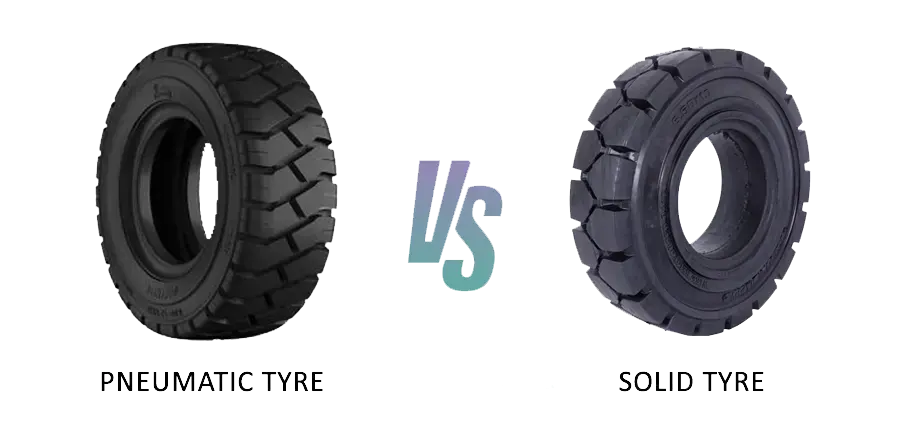Solid tire or Pneumatic tire?
Which One is Right for You?

Choosing the right tire is one of the most common dilemmas forklift operators face. While it may seem like a small detail, tire selection can significantly impact performance, safety, comfort, and operating costs.
In general, forklifts use two types of tires: pneumatic (air-filled) and solid (cushion or press-on). The key to making the right decision lies in understanding the environment in which your forklift will be operating.
🔄 Pneumatic vs. Solid Tires: A Detailed Comparison
✔ Pneumatic Tires
Pneumatic tires are similar to car or truck tires. They are air-filled and provide a cushion between the forklift and the ground.
✅ Advantages:
More Comfortable Ride: They absorb shock and vibrations better, which reduces operator fatigue and provides a smoother driving experience.
Improved Traction: Great for uneven, loose, or slippery surfaces like dirt, gravel, and wet terrain.
Perfect for Rough Outdoor Terrain: They perform well in construction sites, farms, and large outdoor areas.
🚧 Disadvantages:
Puncture Risk: Sharp objects like nails, glass, or metal can cause blowouts, leading to unexpected downtime.
Requires Regular Maintenance: Air pressure must be checked and maintained regularly to ensure optimal performance.
Shorter Lifespan: They wear out faster than solid tires, especially under heavy loads or rough conditions.
👉 Best For:
Outdoor worksites
Uneven or natural terrain
Long-distance forklift operations
✔ Solid Tires
Solid tires are made entirely from rubber, making them incredibly durable and maintenance-free.
✅ Advantages:
Puncture-Proof: No risk of blowouts or flats, even in debris-heavy environments.
Longer Lifespan: Excellent resistance to wear and tear, especially on hard surfaces.
Zero Maintenance: No air pressure checks, no inflations—just install and forget.
Ideal for Heavy Loads: Solid structure provides maximum stability and load-bearing capacity.
🚧 Disadvantages:
Stiff Ride: They don’t absorb shocks well, making the ride less comfortable for the operator.
More Vibration: Excessive vibrations may cause wear on the forklift’s components over time.
Reduced Traction on Rough Terrain: Not suitable for off-road or bumpy surfaces.
Higher Upfront Cost: Generally 2–3 times more expensive than pneumatic tires, so they require a cost-benefit evaluation.
👉 Best For:
Indoor warehouses and factories
Concrete and asphalt surfaces
Areas with high puncture risks (e.g., glass plants, recycling centers)
✅ Final Thoughts: Which Tire Should You Choose?
The best tire depends on where and how you use your forklift:
Indoor, smooth surfaces ➤ Choose solid tires for durability and peace of mind.
Outdoor, rough terrains ➤ Opt for pneumatic tires for traction and operator comfort.
High puncture risk, low maintenance needs ➤ Go with solid tires.
Comfort and smooth driving ➤ Choose pneumatic tires.
💡 Pro Tip:
If your forklift operates mostly outdoors, pneumatic tires are a practical choice. If it’s used in indoor settings with sharp debris or heavy loads, solid tires will save you time and money in the long run.